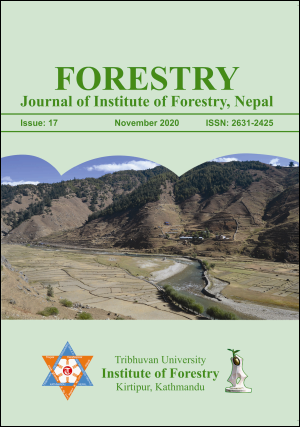An Assessment of Forest Structure, Regeneration Status and the Impact of Human Disturbance in Panchase Protected Forest, Nepal
DOI:
https://doi.org/10.3126/forestry.v17i0.33621Keywords:
Forest, human disturbance, altitudinal gradient, species richness, forest managementAbstract
Vegetation study is crucial for the biophysical environment and ecosystem balance. Both qualitative and quantitative assessments of the vegetation can give complete picture of the forest ecosystem. In this study, quantitative characteristics of Panchase Protected Forest in Kaski district were analyzed. The study was focused on the structural characteristics of forest stand, its regeneration pattern along altitudinal gradients, and human impacts on vegetation structure. Density, basal area, frequency, and Importance Value Index (IVI) were used to assess the structural characteristics of forest; Density-Diameter (DD) curve and seedling/sapling/tree density relation were used to assess the regeneration status. Counting the number of lopping and cut stumps and quantifying fuelwood consumption pattern of the village were used to assess human disturbance. The vegetation survey showed 21, 17 and 14 species of trees, saplings, and seedlings, respectively. Daphniphyllum himalense was the most dominant species followed by Quercus lamellosa. DD curve showed reverse J-shaped structure indicating sustainable regeneration. Daphniphyllum himalense and Alnus nepalensis were major species of trees consumed as fuelwood and average annual fuelwood consumption was 2083.79 tons. Density of lopped trees and cut stump was in decreasing trend along with elevation. Species richness was higher in moderately disturbed sites. This study has significant implications for protected forest management and biodiversity conservation in Nepal.
Downloads
Downloads
Published
How to Cite
Issue
Section
License
© Tribhuvan University, Institute of Forestry




